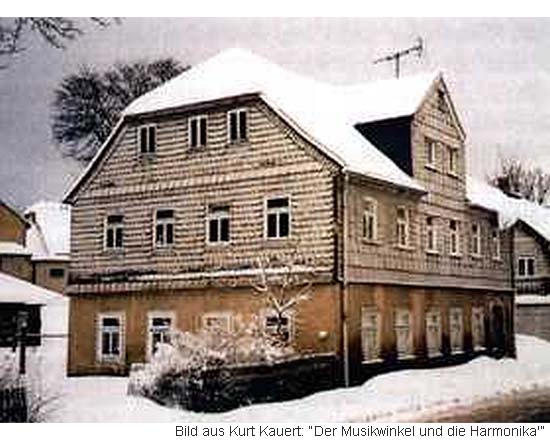
Bandonion
System: Bandonion, 56 tones
bisonoric
(Collection Oriwohl, Nr. IV-23)
Manufacture: unknown, Zinc plates with bronze reeds, 1,49kg
Range: G - cis3, Tone stock for major: G, D, A, E
Uhlig's built his first Concertinas around 1834 in Chemnitz. 13 years later Carl Friedrich Zimmermann also began to produce concertinas not far away in his factory in Carlsfeld (pictured), which he had learned to know and play at Uhlig's in Chemnitz.
Zimmermann built larger instruments than Uhlig with "many rows of keys" and soon the first with 2-choirs in octave interval.

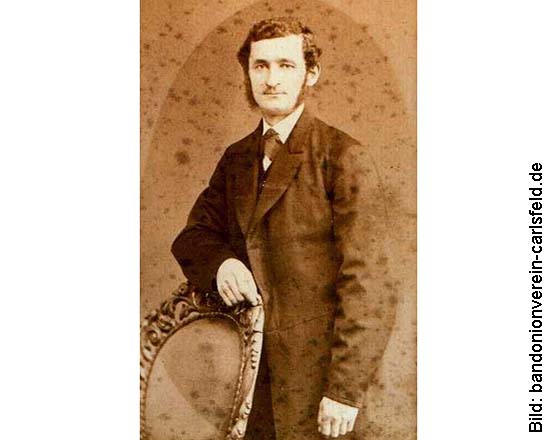
As an eleven-year-old around 1830, C.F. Zimmermann came with his parents from Morgenröte in the Vogtland region to Carlsfeld, not far away. During his apprenticeship as an iron founder in Chemnitz, he became acquainted with Uhlig's concertina, which he also took with him on later trips as a textile merchant. According to his autobiography, it was during this period that he decided in 1840 to build his own instruments:
"A eulogy in the Danzig Steamboat [news paper] about my lovely playing on the harmonica changed my mind. I decided to build such an instrument myself, even bigger, because Uhlig could not be persuaded to do so."
He began in the attic of his parents' house and by 1844 had made three instruments with "many rows of keys". In 1847 he moved into his Concertina factory, for which up to 76 employees worked at peak times.

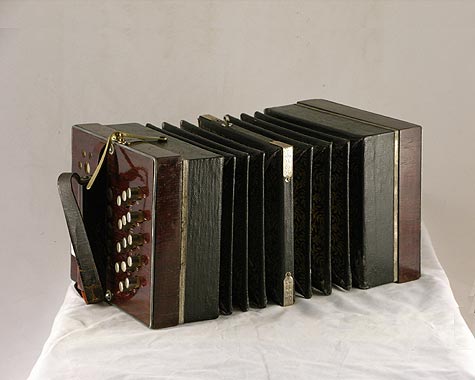
The instrument shown here was not made during Zimmermann's time as a concertina maker, but later. However, it corresponds to the design of Zimmermann and Uhlig, including the manuals, which is why it is representative of Zimmermann's early products.
The instrument differs from Uhlig's Chemnitz system in three keys. These changes are contained identically in the playing instructions published by both Zimmermann and Heinrich Band around 1850 and correspond to the tone assignment of the concertinas later called Bandonion. It is not known who made the changes to the tone assignment.
In the years that followed, Zimmermann and/or Band expanded the tone stock of concertinas. This first keyboard concept, now known as Bandonion of Rhenish sytem, was later changed again by Zimmermann and/or Ernst Louis Arnold and subsequently established itself under the name Carlsfelder Concertina.
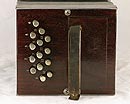
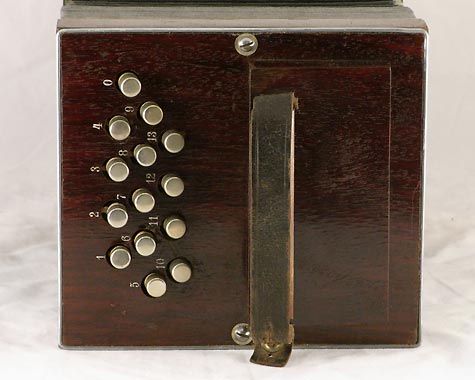
Left side: G - f1
This instrument has a total of 56 tones, of which a third are 19 repetition tones, i.e. duplicate.
A total of 37 different tones can be played on this instrument.
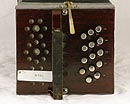
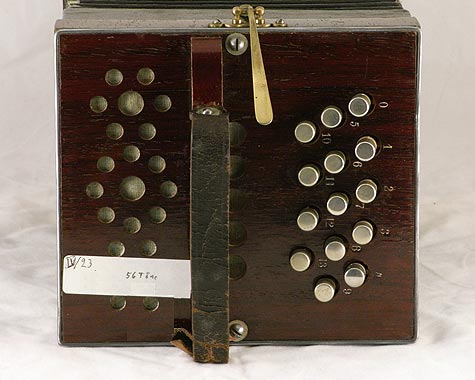
Right side: g1 - c#3
The button arrangement shown corresponds to the Chemnitz system, but the tone assignment of the keys and their numbering is different:
1-2-3-4-0 the Chemnitz system and
0-1-2-3-4 the Carlsfeld and the Rhenish system.
Accordingly, on the manual shown, key 0 is moved from the last seat in row 3 to the first and keys 1 to 4 move down one place with their tone assignment.
On a 58-note concertina, 3 out of 14 keys differ in tone assignment on the right. (The concertina shown is a 56-note one with only 13 keys and 2 changes.)
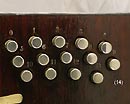
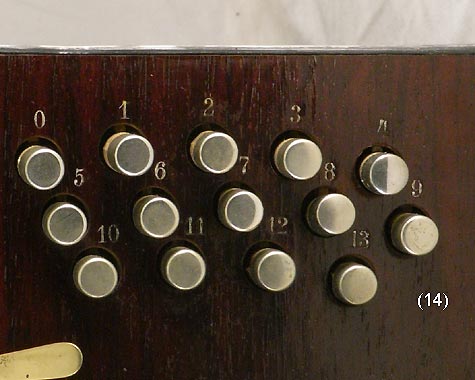
Right manual
This key block 0-13 is part of all Deutsche Konzertinas and Bandonions, but with different tone assignment depending on the system used.
The different keyboard systems also required three different editions of the Griffschrift notation for a piece of music.
(The logical numbering can only be continued for one key 14 in the case size of the model shown.)

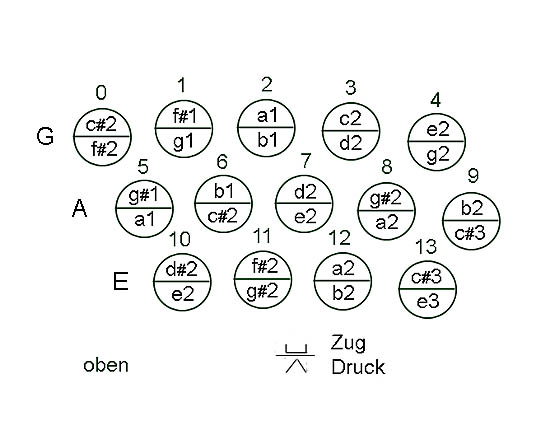
Right manual with 3 rows of major keys: G, A and E.
C.F. Uhlig's Chemnitz system consists of two homogeneous, logical series with recurring tone intervals. On the 56-note bandonion shown here, this logic is not continued and is even abolished, because the keys 8 and 9 are given a tone assignment that differs from Uhlig's:
From key 8, the sixth f#2 of A major disappeared, and the seventh g#2 of Uhlig's key 9 took its place. Instead, this was assigned b2 and thus A major was extended by 2 tones on key 9.
These changes are the beginning of a systemless, increasingly chaotic tone assignment: the A major series, in contrast to G, E, lacks the sixth. In G and E major, the sixth/root are on one key (4, 13). In A major, on the other hand, there are seventies/root on (8)

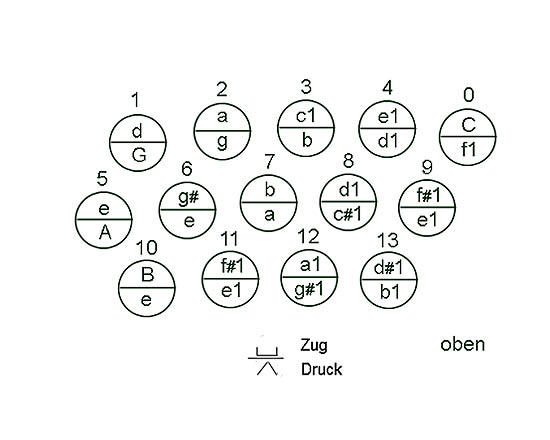
Tone assignment left manual:
Identical to Uhlig's Chemnitz system, except for key 13, which is assigned c#1/b1 by Uhlig.
It is not possible to determine from the few sources who came up with these both-sided changes in the tone assignment of a total of four keys, whether Zimmermann or Band. Both instructions, Band's "Practische Schule für das 88 tönige Accordion" from 1850 and Zimmermann's "Praktischer Selbstlehrer für Concertina" from 1851 contain them. It may also have been included in Zimmermann's 1849 advertised but lost edition of the "Table for Accordion with 58 Tones, Improved Construction".
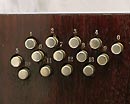
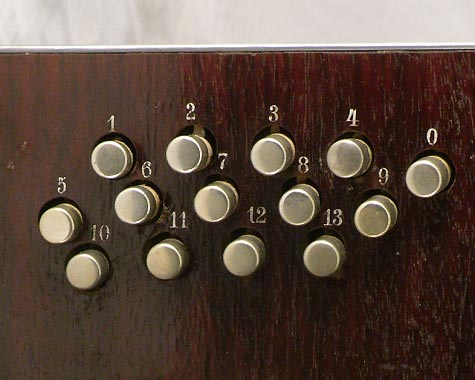
Left manual:
Same manual (including numbering) at Chemnitz system, but with different tones on key 13.
C.F. Zimmermann also introduced the 2-choir system called "octave pressure", which represents the decisive innovation for the sound of the bandonion and patented it in Saxony. (C.F. Buschmann had previously failed in Prussia because the patent office considered the principle to be known from organ building.)
However, Zimmermann reported about a low demand for two-choir instruments, suggesting that concertinas were mainly used as melody instruments with a clear one-chord sound.

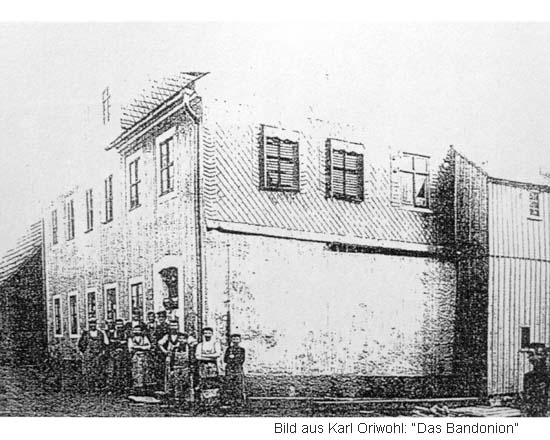
Over the years, C.F. Zimmermann faced increasing competition from other manufacturers, especially in neighbouring Klingenthal. This could be one reason why he emigrated to his brother in Philadelphia in the United States in 1864. In that year he sold his concertina factory to Ernst Louis Arnold, who continued production under the ELA brand and later built a new building.
E.L. Arnold's son, Alfred Arnold, initially ran his instrument manufacturing company, founded in 1911, in Zimmermann's factory, in front of which his employees can be seen in the picture. In the 1930s, the Alfred Arnold company became the main supplier of tango musicians in Argentina.
C.F. Zimmermann continued to be interested in new instruments in the USA and made the Autoharp popular there.
